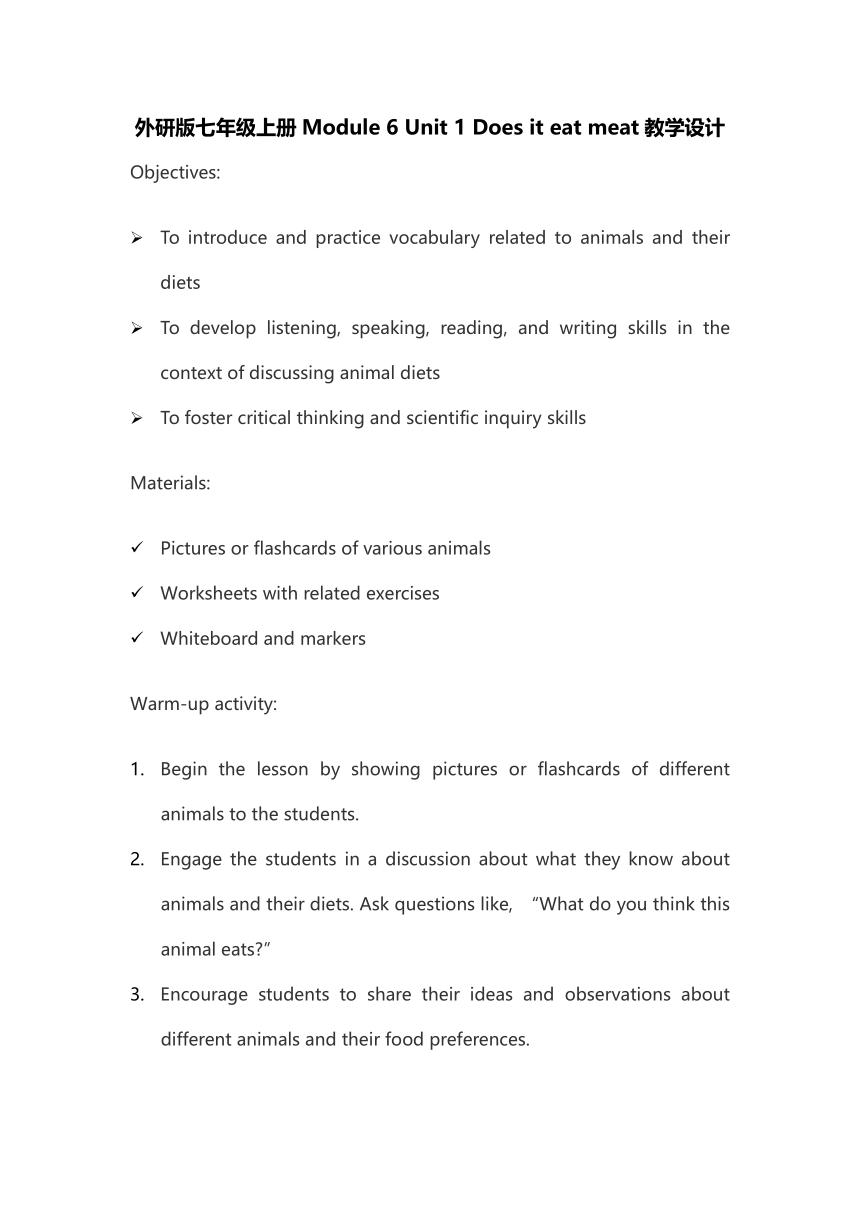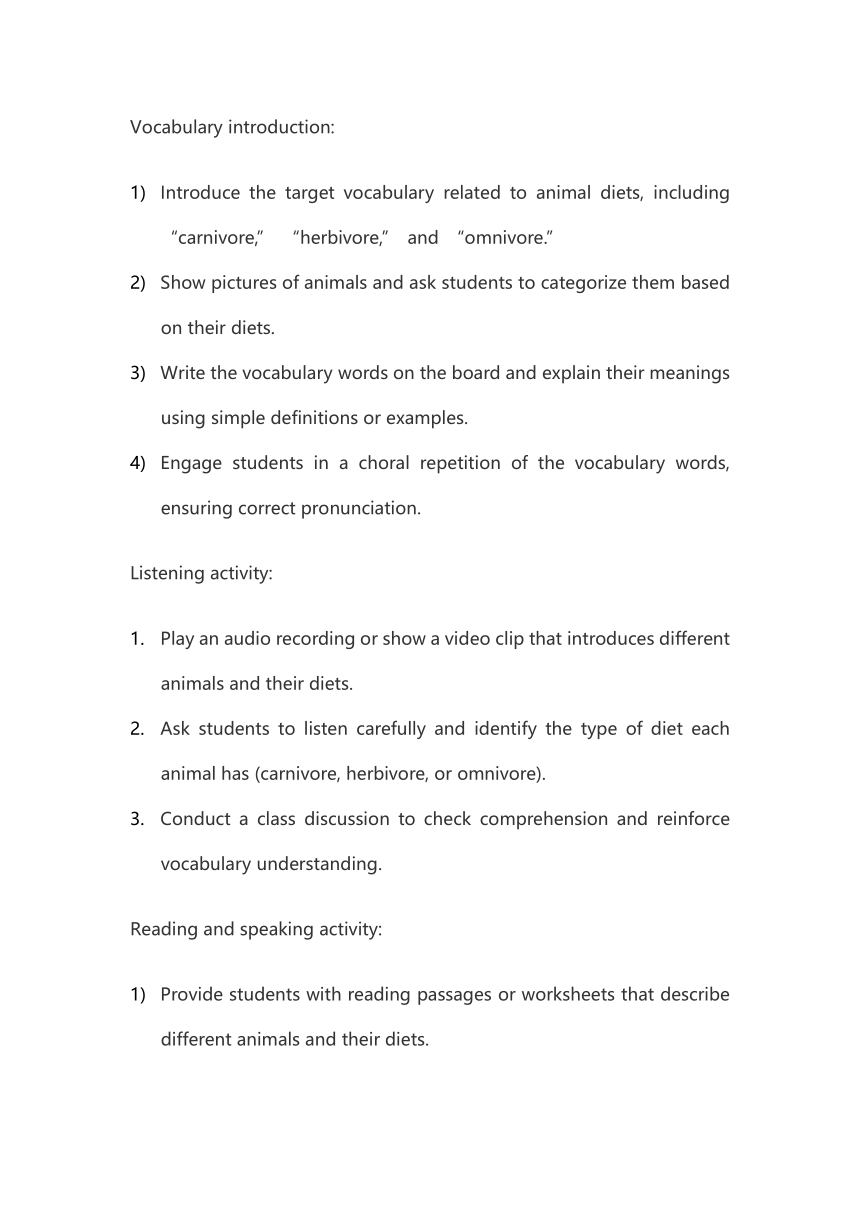外研版七年级上册Module 6 Unit 1 Does it eat meat?教学设计
文档属性
| 名称 | 外研版七年级上册Module 6 Unit 1 Does it eat meat?教学设计 |

|
|
| 格式 | docx | ||
| 文件大小 | 18.0KB | ||
| 资源类型 | 教案 | ||
| 版本资源 | 外研版 | ||
| 科目 | 英语 | ||
| 更新时间 | 2023-08-21 16:13:10 | ||
图片预览


文档简介
外研版七年级上册Module 6 Unit 1 Does it eat meat教学设计
Objectives:
To introduce and practice vocabulary related to animals and their diets
To develop listening, speaking, reading, and writing skills in the context of discussing animal diets
To foster critical thinking and scientific inquiry skills
Materials:
Pictures or flashcards of various animals
Worksheets with related exercises
Whiteboard and markers
Warm-up activity:
Begin the lesson by showing pictures or flashcards of different animals to the students.
Engage the students in a discussion about what they know about animals and their diets. Ask questions like, “What do you think this animal eats ”
Encourage students to share their ideas and observations about different animals and their food preferences.
Vocabulary introduction:
Introduce the target vocabulary related to animal diets, including “carnivore,” “herbivore,” and “omnivore.”
Show pictures of animals and ask students to categorize them based on their diets.
Write the vocabulary words on the board and explain their meanings using simple definitions or examples.
Engage students in a choral repetition of the vocabulary words, ensuring correct pronunciation.
Listening activity:
Play an audio recording or show a video clip that introduces different animals and their diets.
Ask students to listen carefully and identify the type of diet each animal has (carnivore, herbivore, or omnivore).
Conduct a class discussion to check comprehension and reinforce vocabulary understanding.
Reading and speaking activity:
Provide students with reading passages or worksheets that describe different animals and their diets.
In pairs or small groups, have students read the passages and discuss the diets of the animals mentioned.
Encourage students to use the target vocabulary and provide reasons or evidence for their answers.
Monitor the discussions and provide assistance as needed, ensuring that all students actively participate.
Writing activity:
Distribute worksheets or handouts with a short writing task.
Instruct students to choose an animal and write a paragraph describing its diet, using the target vocabulary.
Encourage students to incorporate facts and details into their writing.
Collect the completed paragraphs and provide feedback on grammar, vocabulary, and organization.
Group activity :
Divide the class into small groups and assign each group an animal from a given list.
Instruct the groups to research and gather information about the assigned animal’s diet.
Encourage the groups to create a short presentation or poster showcasing their findings, including the type of diet and examples of the animal’s food.
Have each group present their project to the class, allowing for questions and discussions.
Wrap-up activity :
Recap the main points covered in the lesson, emphasizing the vocabulary related to animal diets.
Ask students to reflect on what they’ve learned and share any interesting or surprising information they discovered.
Close the lesson by encouraging students to continue exploring and observing animals’ diets in their daily lives.
Extension activity (optional):
If time permits, you can incorporate the following activities to further engage the students:
Organize a visit to a local zoo or wildlife sanctuary, allowing students to observe different animals and their diets firsthand.
Conduct a class debate where students discuss the advantages and disadvantages of different animal diets.
Assign a research project where students investigate and present on a specific animal’s diet, its ecosystem, and its role in the food chain.
Objectives:
To introduce and practice vocabulary related to animals and their diets
To develop listening, speaking, reading, and writing skills in the context of discussing animal diets
To foster critical thinking and scientific inquiry skills
Materials:
Pictures or flashcards of various animals
Worksheets with related exercises
Whiteboard and markers
Warm-up activity:
Begin the lesson by showing pictures or flashcards of different animals to the students.
Engage the students in a discussion about what they know about animals and their diets. Ask questions like, “What do you think this animal eats ”
Encourage students to share their ideas and observations about different animals and their food preferences.
Vocabulary introduction:
Introduce the target vocabulary related to animal diets, including “carnivore,” “herbivore,” and “omnivore.”
Show pictures of animals and ask students to categorize them based on their diets.
Write the vocabulary words on the board and explain their meanings using simple definitions or examples.
Engage students in a choral repetition of the vocabulary words, ensuring correct pronunciation.
Listening activity:
Play an audio recording or show a video clip that introduces different animals and their diets.
Ask students to listen carefully and identify the type of diet each animal has (carnivore, herbivore, or omnivore).
Conduct a class discussion to check comprehension and reinforce vocabulary understanding.
Reading and speaking activity:
Provide students with reading passages or worksheets that describe different animals and their diets.
In pairs or small groups, have students read the passages and discuss the diets of the animals mentioned.
Encourage students to use the target vocabulary and provide reasons or evidence for their answers.
Monitor the discussions and provide assistance as needed, ensuring that all students actively participate.
Writing activity:
Distribute worksheets or handouts with a short writing task.
Instruct students to choose an animal and write a paragraph describing its diet, using the target vocabulary.
Encourage students to incorporate facts and details into their writing.
Collect the completed paragraphs and provide feedback on grammar, vocabulary, and organization.
Group activity :
Divide the class into small groups and assign each group an animal from a given list.
Instruct the groups to research and gather information about the assigned animal’s diet.
Encourage the groups to create a short presentation or poster showcasing their findings, including the type of diet and examples of the animal’s food.
Have each group present their project to the class, allowing for questions and discussions.
Wrap-up activity :
Recap the main points covered in the lesson, emphasizing the vocabulary related to animal diets.
Ask students to reflect on what they’ve learned and share any interesting or surprising information they discovered.
Close the lesson by encouraging students to continue exploring and observing animals’ diets in their daily lives.
Extension activity (optional):
If time permits, you can incorporate the following activities to further engage the students:
Organize a visit to a local zoo or wildlife sanctuary, allowing students to observe different animals and their diets firsthand.
Conduct a class debate where students discuss the advantages and disadvantages of different animal diets.
Assign a research project where students investigate and present on a specific animal’s diet, its ecosystem, and its role in the food chain.
同课章节目录
- Starte
- Module 1 My teacher and my friends
- Module 2 My English lesson
- Module 3 My English book
- Module 4 My everyday life
- Module 1 My classmates
- Unit 1 Nice to meet you.
- Unit 2 I'm Wang Lingling and I'm thirteen years ol
- Unit 3 Language in use.
- Module 2 My family
- Unit 1 Is this your mum?
- Unit 2 These are my parents.
- Unit 3 Language in use.
- Module 3 My school
- Unit 1 There are thirty students in my class.
- Unit 2 The library is on the left of the playgroun
- Unit 3 Language in use.
- Module 4 Healthy food
- Unit 1 We've got lots of apples.
- Unit 2 Is your food and drink healthy?
- Unit 3 Language in use.
- Module 5 My school day
- Unit 1 I love history.
- Unit 2 We start work at nine o'clock.
- Unit 3 Language in use.
- Revision module A
- Module 6 A trip to the zoo
- Unit 1 Does it eat meat?
- Unit 2 The tiger lives in Asia.
- Unit 3 Language in use.
- Module 7 Computers
- Unit 1 How do I write my homework on the computer?
- Unit 2 When do you use a computer?
- Unit 3 Language in use.
- Module 8 Choosing presents
- Unit 1 I always like birthday parties.
- Unit 2 She often goes to concerts.
- Unit 3 Language in use.
- Module 9 People and places
- Unit 1 We're enjoying the school trip a lot.
- Unit 2 They're waiting for buses or trains.
- Unit 3 Language in use.
- Module 10 Spring Festival
- Unit 1 Are you getting ready for Spring Festival?
- Unit 2 My mother's cleaning our houses and sweepin
- Unit 3 Language in use.
- Revision module B
